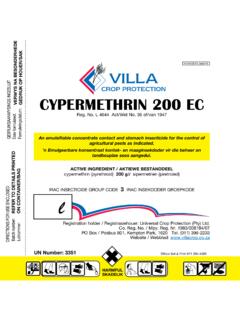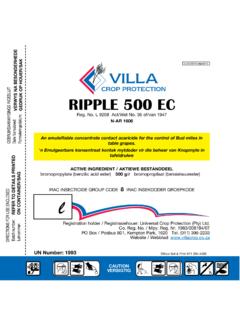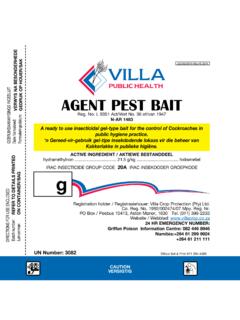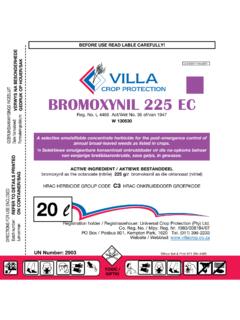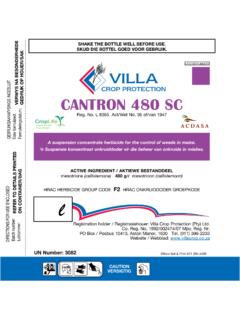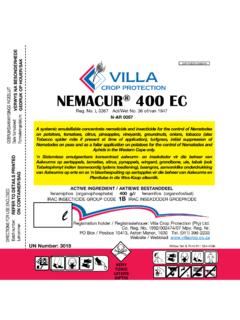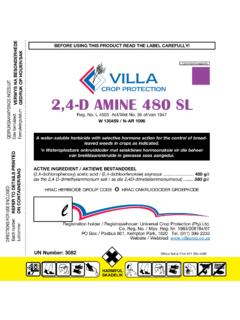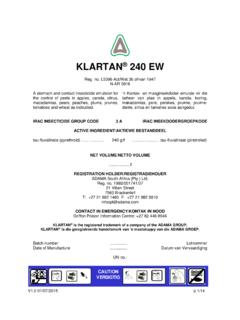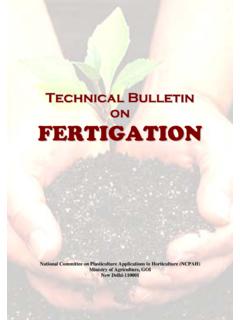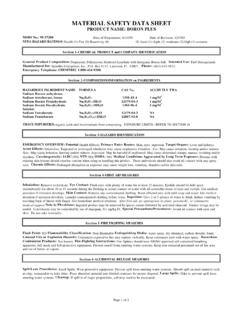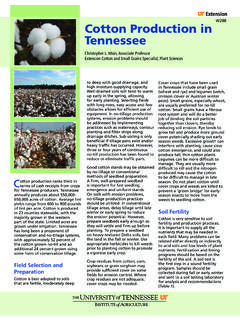Transcription of SOLUBOR - Villa Crop
1 SOLUBOR . Sodium Borate Natriumboraat Boron 205 g/kg Boor Reg. B 2740: Act/Wet 36 of/van 1947 Fertiliser - Grp 2 - Misstof Mass 25 kg Massa Registered by / Geregistreer deur: CHEMPAC (Pty) Ltd. Reg. No. 2002/007885/07. P O Box / Posbus 516, Suider Paarl 7624. Nr. (021) 874 1055. SOLUBOR is the registered trade mark of Borax International Limited SOLUBOR is die geregistreerde handelsnaam van Borax International Limited GENERAL: SOLUBOR is readily soluble in water and may be applied to plants as a foliar spray. Different crops exhibit a wide variety of symptoms, and if boron deficiency is suspected, confirmation should always be sought from a qualified Agronomist or Agricultural Advisory Officer before application of SOLUBOR .
2 WARNINGS: Do not exceed the application rates given below, because some crops have a low tolerance to boron. Never apply SOLUBOR as a seed dressing. DIRECTIONS FOR USE: Use only as directed Compatibility: SOLUBOR may be sprayed together with most crop protection chemicals and urea. NOT compatible with Zinc sulphate, Manganese sulphate, Lime sulphur, winter and summer oils or miscible oil formulations. Availability of Boron: The availability of Boron in the soil for uptake by plants could be influenced by a number of factors such as pH, Calcium in the soil and the application of lime. It is therefore essential that SOLUBOR be applied as a foliar spray to plants that are grown in such soils during the peak demand periods.
3 CROP DOSAGE / 100 WATER REMARKS (All applications are as foliar sprays unless otherwise indicated). Maize Foliar application: 1 - 2 kg / ha Apply as a foliar spray between the 8-leaf stage and start of silking. Soil application: Spray evenly over the soil before final planting preparation, except where leaf analyses of 0-15 % clay: 4 kg/ha the previous crop may allow omission of treatment. 16-30 % clay: 8 kg/ha >31% clay: 10 kg/ha Sunflowers Foliar application: 750gms - 2,4kg/ha Apply as a full cover spray between 5 pairs of leaves and flower button stage. Soil Application Wherever sunflowers are grown, spray evenly over the soil before the final preparation of the 0-15% clay: 4 - 5 kg/ha seedbed EXCEPT where the leaf analysis of the previous crop justifies its omission.
4 May be 16-30% clay: 8 - 10 kg/ha mixed with trifluralin as a tank mix. SOLUBOR must be completely dissolved before the >31% clay: 10 15 kg/ha herbicide is added to the spray tank. Groundnuts Foliar application: Apply 350 g SOLUBOR as an aerial or tractor spray 4 5 times per season at 3 weekly 350 - 875 g/ha intervals. Alternatively apply 875 g/ha twice, starting at pegging stage Soya beans Foliar application: Apply at first flowering. A second application may be necessary 2 weeks afterwards 1 2 kg/ha Pome fruit: Foliar applications: Apples, Pears 100 200g 4 weeks post harvest, according to the January leaf analysis. 100 -120 g 30 % flowering 50 - 60 g Week 43, week 45, week 47, week 49, week 50 and week 51.
5 If leaf analysis shows high levels of Boron the number of these applications could be reduced, starting with week 43. and 50. Stone fruit: Foliar applications: Peaches, Plums, 100 - 120 g 4 weeks post harvest, according to the January leaf analysis. Apricots and Cherries 100 - 120 g Four two-weekly applications starting at 90 % petal fall. Citrus Foliar application: 100 - 200 g Bud swell. 100 150 g 5 7 days after petal fall. The amount of boron and number of applications should be determined by leaf analysis. Apply in 1 000 - 2 000 water/ha as a full cover spray. Soil application: Distribute evenly in the drip zone of each tree.
6 Do not repeat within 3 years. Do not apply to Maximum of 50 - 60 g/tree young trees. CROP DOSAGE / 100 WATER REMARKS (All applications are as foliar sprays unless otherwise indicated). Potatoes Foliar application: Apply as an aerial or tractor spray 4 or 5 times per season with 3-weekly intervals during the 350 - 500 g/ha first year. During the following years apply only 2 such sprays per year. Lucerne Foliar application: 0-15% clay: 4 kg/ha Wherever the analysis of the top 150 mm of the plant, before flowering, contains less than 16-30% clay: 8 kg/ha 20 mg boron/kg (ppm), spray overall after cutting. >31% clay: 10 kg/ha Brassicae Foliar application: Apply as a foliar spray at early vegetative phase.
7 6 kg/ha Soil application: At planting time. The treatment can be added to pre- or post emergence herbicides. Consult 6 12 kg/ha distributor to confirm compatibility of products. Grapes Foliar applications: 100 120 g 6 7 leaf stage 100 200 g Post harvest treatment depending on leaf analysis. Cotton Foliar application: Apply as a full cover spray with or shortly after flowering stage. 600 700 g/ha Flowers and Foliar application: Apply 2-3 sprays at monthly intervals, starting as soon as plants are established. ornamentals 100 140 g Tomatoes Foliar application: Apply as full cover spray. Repeat when new leaves have formed. 750 g Onions Foliar application: Apply first treatment 3 weeks after plants are established and repeat 3 weeks later.
8 600 700 g/ha
